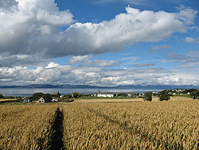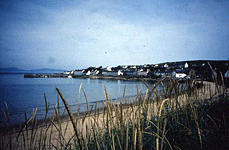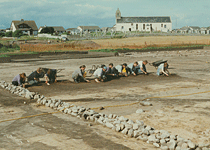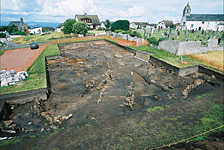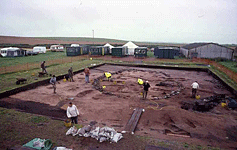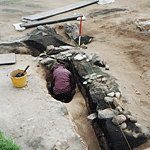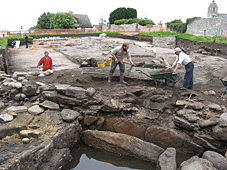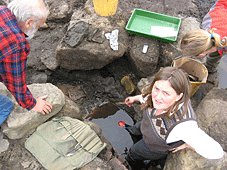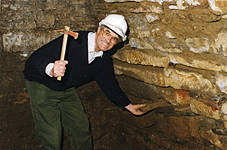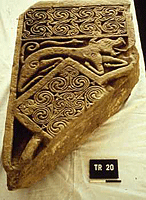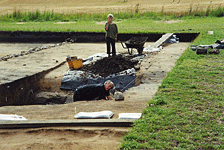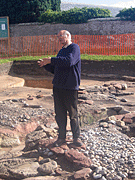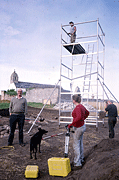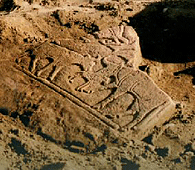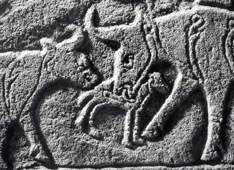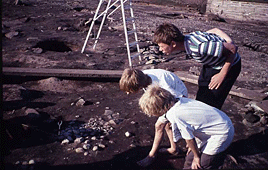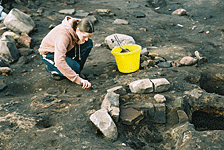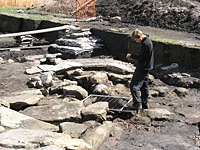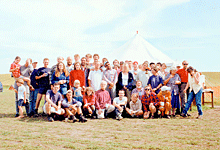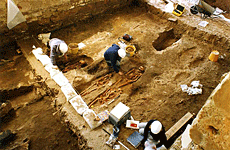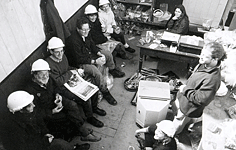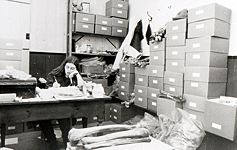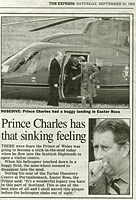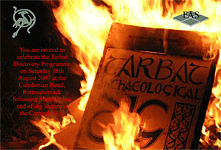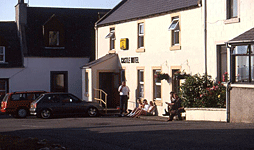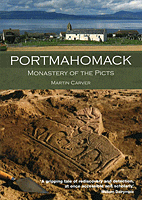Tarbat, Monasticism & Iconography
Portmahomack excavations
Tarbat is a peninsula jutting out into the North Sea -there are many Tarbat or Tarbet place names, meaning portage, mostly on the west coast of Scotland - between the Cromarty and Dornoch firths in Easter Ross, north-east Scotland, about half way between Inverness and Wick. In many ways Tarbat, and in particular the excavations at Portmahomack, proved to be the natural successor to Sutton Hoo, focusing Martin's thinking on the formation of a Pictish kingdom, the role of Christian conversion, monasticism and the place of iconography, in the form of the magnificent Pictish sculpture, found in abundance on Tarbat, at Nigg, Shandwick, Hilton of Cadboll and Portmahomack itself. But it was not a given at the outset, as, unlike Sutton Hoo, Tarbat was a foray into an almost unknown site which flourished between the 6th and 10th centuries AD.
The range of investigations refined at Sutton Hoo was deployed between 1994 and 2007 at Tarbat, resulting in a window, opened on an unprecedented scale, on early monasticism, inspired by the Columban mission to Scotland in the late 6th century AD. It was a truly collaborative venture, involving survey on the Tarbat peninsula, the full excavation of the Church of St Colman and a one hectare sample of the area within the enclosure that surrounds the church. It was carried out in collaboration with a host of institutions: chief amongst them are the Department of Archaeology at York, Field Archaeology Specialists, the Tarbat Historic Trust, Historic Scotland, the Heritage Lottery Fund, Highland Council, the European Research and Development Fund, and Ross and Cromarty Enterprise. For more information on the project, including all its Bulletins and Data Structure Reports, see http://www.york.ac.uk/depts/arch/staff/sites/tarbat/
Field Archaeology Specialists was involved in the Tarbat project right from the start. One of its directors, Justin Garner-Lahire, seen here excavating the mill, writes:
"By 1993 FAS had been formed, and Martin was looking for new research opportunities. The invitation to study a possible early Christian site in Pictland was particularly tempting. The first two evaluation seasons produced promising results, but did not betray the enormity of the project we were about to embark on. The early years of the project were particularly demanding for Martin, with the pressures of designing the research programme, the church restoration and display design, and fund-raising for the entire project, on top of writing-up Sutton Hoo, and his Head of Department and teaching obligations. The site itself then turned out to be the most archaeologically challenging that any of us had encountered, but proved to be rewarding in equal measure - the rise and fall of a Pictish monastery, its cemetery and workshops with fine metal-working, beautiful sculpture, vellum-making and much, much more. For me, managing Tarbat proved to be a formative experience, and I thank Martin for the opportunity, and particularly for his unwavering support through some difficult times. With much relief all round, the fieldwork was finally completed in 2007 and we are now embarking on the post-excavation and write-up. Typically, he's already written and published a book on the project!
Martin, I'm so pleased you are giving up the day job. I'm very much looking forward to spending more time working with you on new and existing projects."
JUSTIN GARNER-LAHIRE
Cecily Spall first came to Tarbat as a York undergraduate some 12 years ago. It is her dedication to the project, her impeccable standards of fieldwork and recording, and her flair for combining the material culture with the site data that have made her Martin's remarkable co-director on the project. She writes:
"It is difficult to summarise Tarbat without being either too serious or too irreverent. Tarbat was an unusually rich site in many ways and many things to many people - over 300 people worked there. Martin's sixth sense was aroused when he first visited the Port and the ensuing fourteen years of excavation meant lots of happy rewarding days on site for lots of students, volunteers and archaeologists. Off-site, life in the Port was memorable for impromptu ceilidhs in the marquee kicked off by Martin (dulcet tones) and Donald Urquhart (on the accordion). Several thrusty bouts of 'Stripping the Willow' later, many bruised bingo wings, several partnerships, marriages and subsequent children can be owed to Tarbat's special mixing pot. By way of a tribute, a small collection of anecdotes from working with Martin follows interspersed with some of the less serious photographs in the project archive.
What've you found that's good?
On one particularly overcast, warm and windless day the midges descended and proceeded to attack. For Martin, in typical military strategist fashion, the decision that his best defence would be to dig in his T-shirt vest and wrap his shirt around his head Ali Baba-style was quickly taken. To complete his turbaned look Martin added unpredictable slapping of his remaining exposed flesh accompanied by some muttering. This resulted in reddened skin marked with the small black corpses of many midges. That same morning a large coach party visited the museum and having seen the exhibition two tourists came to have a look at the dig. A well-boned man and his (nearly identical) mother, having established that Martin was our leader, shouted across the fence in a broad Bradford accent: "What've you found that's good?" Needless to say Martin initially feigned deafness - his shirt-turban must have been playing with his hearing. When the Bradfordians persisted by shouting "Have you found any gold or swords?" Martin, who could resist no longer, popped his head above the trench and replied in all seriousness: "No, they're further down". Naturally enough the tourists were totally satisfied with his response and happily boarded their coach.It seems only fitting to finish the contribution with some poetry - Martin always manages to effortlessly blend his writing with some appropriate poetry and I've attempted to do the same for old time's sake wi' a bit o Rabbie (my translation in brackets in the spirit of Tarbat):
For auld land syne, my dear,
For auld lang syne
We'll tak a cup of kindness yet (pint of whisky)
For auld lang syneAnd there's a hand my trusty fiere (friend)
And gie's a hand o thine
And we'll tak a right guid willie-waught (erm...)
For auld land syne"CECILY SPALL
Cecily contributed these photographs of Martin in action at Tarbat.
Martin prepares to delicately remove the ancient Pictish 'Dragon Stone' from the vault of the crypt
Martin digging the Tarbat enclosure ditch while an enslaved Jacques practices sign language
Martin on the weekly site tour tries to persuade us that he is standing in a Roman bathhouse
Martin and our old dig dog Jasper
There were many highlights at Tarbat: the thrill of uncovering remarkable artworks, not only in the church's fabric, where they were more or less expected, but out in the open area excavation (pictured here). Coming face to face with an image emerging from the soil is a unique experience, shared here by three Carvers. More painstaking, but of enormous import, was the piecing together of the hundreds of fragments of material evidence which showed that Portmahomack was indeed a monastic site which manufactured fine ecclesiastical metalwork and parchment (see Carver & Spall 2004). While originally reluctant to see Portmahomack as a monastery, Martin has come to endorse the monastic model - albeit a very idiosyncratic form of monastic establishment - which was discussed in a series of seminars with guests from Britain and Ireland during summer 2007. A true 'Iona of the East' (see Carver 2004).
As at Sutton Hoo, the campaigns were conducted on a number of different fronts. On site they involved the participation of a professional Unit, of volunteers - local and from outside, including Carver children - and of a training school of the University of York (the team is assembled here in 1997). It included the full excavation of the Church of St Colman, prior to its conversion into a museum: the church is shown here under excavation, as is its team and Louise Henderson (later Brennan) recording the hundreds of skeletons and disarticulated human bones from the church's long sequence. Sarah King who analysed the bones found that the early burials of the 6th to 9th centuries were almost all adult males. The possibility that they were monks is a very real one.
As at Sutton Hoo too, the long-term survival of the church and its site has been a concern. It resulted in the conversion of the church into the Tarbat Discovery Centre, opened by Prince Charles in 1999, whose helicopter got stuck in the mud of the Glebe field. For more information, see the Centre's website: http://www.tarbat-discovery.co.uk/
The fieldwork at Tarbat ended in 2007, leaving Martin, Cecily, and many collaborators with the task to produce the full research report. The team will no longer be such frequent visitors to the Castle pub but it is sure of a welcome in the Port, as Martin has made so many friends there.
References (MOHC bibliography)
- 1995 (ed.). Bulletin of the Tarbat Discovery Programme 1.
- 1996 (ed.). Bulletin of the Tarbat Discovery Programme 2.
- 1997 (ed.). Bulletin of the Tarbat Discovery Programme 3.
- 1998. Hilton of Cadboll: an archaeological assessment and project design. Unpublished report, University of York.
- 1998 (ed.). Bulletin of the Tarbat Discovery Programme 4.
- 1999 (ed.). Bulletin of the Tarbat Discovery Programme 5.
- 1999. Exhibition text for Tarbat Discovery Centre (opened by Prince Charles, Duke of Rothesay October 1999).
- 1999 (with Elizabeth Hooper). Discovery at Tarbat (site guidebook).
- 2000 (ed.). Bulletin of the Tarbat Discovery Programme 6.
- 2001. Tarbat, in M. Lynch (ed.) The Oxford Companion to Scottish History: 594-5. Oxford: Oxford University Press.
- 2002 (ed.). Bulletin of the Tarbat Discovery Programme 7 (2001-2002).
- 2004. An Iona of the East: the early medieval monastery at Portmahomack, Tarbat Ness. Medieval Archaeology 48: 1-30.
- 2004 (with Cecily Spall). Excavating a parchmenerie: archaeological correlates of making parchment at the Pictish monastery at Portmahomack, Easter Ross. Proceedings of the Society of Antiquaries of Scotland 134.
- 2004 (ed., prepared by Cecily Spall). Tarbat Discovery Programme, data structure report 2004.
- 2004. Prize-winner, English Heritage/CADW/Historic Scotland open prize for communicating research to the public (BAAS meeting, Exeter).
- 2005 (ed., prepared by Cecily Spall). Tarbat Discovery Programme, data structure report 2005.
- 2006. A Columban monastery in Pictland. Current Archaeology 205: 20-29.
- 2006 (ed., prepared by Cecily Spall). Tarbat Discovery Programme, data structure report 2006.
- 2008. Portmahomack: monastery of the Picts. Edinburgh: Edinburgh University Press.
- 2008. Post-Pictish problems: the Moray firthlands in the 9th-11th centuries. Rosemarkie: Groam House Museum.
- 2008. The Pictish monastery at Portmahomack (Jarrow lecture 2008). Newcastle: Bealin.
- In prep. (with Cecily Spall). The early monastery at Portmahomack, Tarbat Ness, Ross-shire. Society of Antiquaries of Scotland.
Thinking about iconography (MOHC bibliography)
This section contains bibliographical references to publications on iconography not already mentioned in the site-specific references to Tarbat.
- 1979. Contribution to P.V. Addyman & I. Goodall: The Norman church and door at Stillingfleet. Archaeologia 106: 74-105.
- 1980. A 12th century tympanum fragment at Caverswall, Staffordshire. North Staffordshire Journal of Field Studies 20: 1-8.
- 1986. Contemporary artefacts illustrated in Late Saxon manuscripts. Archaeologia 108: 117-45.
- 1999. Surviving in symbols: a visit to the Pictish nation (The Making of Scotland series). Edinburgh: Canongate (reprinted 2005 by Birlinn & Historic Scotland).
- 1999. Shielding identity: some comments on objects and images in Pictish carving, in S. Bennett (ed.) Pictish Art (Proceedings of a conference held at Elgin): 7-9. Elgin: Elgin Museum.
- 1999. Review of I.M. Stead The Salisbury Hoard. British Museum Magazine 33: 39.
- 2005. Sculpture in action: contexts for the stone carving on the Tarbat peninsula, Easter Ross, in S. Foster & M. Cross(ed.) Able minds and practised hands: Scotland's early medieval sculpture in the 21st century (Society for Medieval Archaeology Monograph). Leeds: Maney & Edinburgh: Historic Scotland.
- 2007. Review of R. Cramp Corpus of Anglo-Saxon stone sculpture, volume VII: South-West England in Antiquity 81: 238-40.
